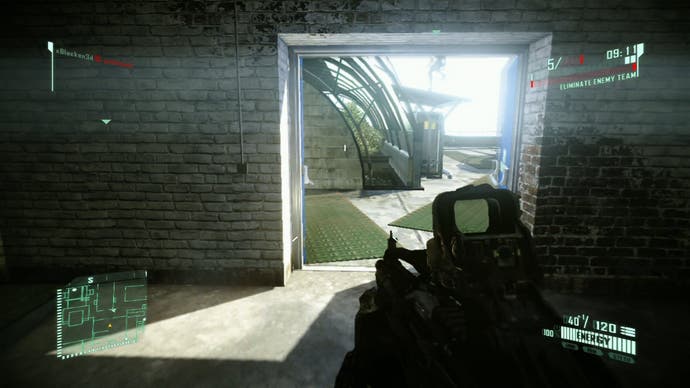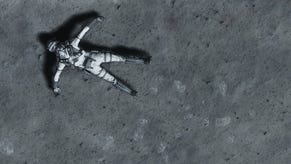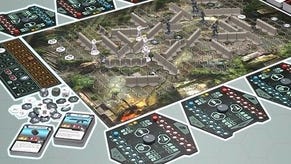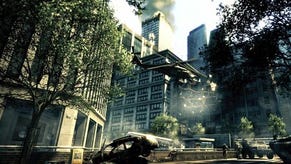Tech Analysis: Crysis 2 Demo
Crytek analysis!
Central to the game's look and feel is the implementation of real-time global illumination. The notion of GI isn't exactly new to video games - calculation of lighting has obviously been going on for a very, very long time. Designers create the levels, they're lit within the editor and then the process of calculating light and shadow is carried out in a time-intensive offline procedure. The original Quake from id Software was one of the earliest examples, and the developers had a series of SGI workstations dedicated to processing the lighting on the levels so they could get to see the results of their work in a relatively timely manner. Even today, games like Uncharted 2: Among Thieves use offline processing to "bake in" GI, while it remains a significant factor in Unreal Engine - a tech that Crytek hopes to challenge as the preferred middleware solution.
With CryEngine 3, the developers can adjust lighting on the fly and immediately see how it looks as the game actually runs on PS3, 360 and PC. This saves an enormous amount of time, of course, but also has implications for the player in terms of shifting lighting (time of day, for example). The notion of such an inordinately complex task being carried out in real-time on five-year-old console tech is hugely significant and is a massive technical accomplishment for the Frankfurt-based developer.
Real-time global illumination is one of the key innovations in CryEngine 3, but it is interesting to note that many areas of the tech have been carried over from the original Crysis tech. We know this not just from the various developer demonstrations Crytek has given where tools and configs looked similar to that used for Crysis, but also because the Xbox 360 demo can be decrypted and unpacked, giving us a .cfg config file with a huge array of variables that have much in common with the existing PC releases of CE2 games, of which Crysis Wars was the most recent example.


Way back in December 2009, our Can Consoles Run Crysis? feature saw us attempt to recreate Crytek's demos within the existing PC game, and guest contributor Nebula rebuilt a PC config based on the visual make-up of the 360 and PS3 footage. His conclusion was that CE3 on console was based on the PC game's "medium" quality setting with some elements dialled back, while others operated on the equivalent of the "very high" setting. Fast forward to 2011 and the ability to see the consoles' actual .cfg file validates the majority of his findings.
InCrysis forum member Doomlord52 went one stage further and actually carried out a point-for-point comparison between the 360 .cfg and what was seen in Crysis Wars on PC, and the conclusions there are enlightening - RAM-heavy features of CryEngine are scaled back to medium settings or even lower, but processing-intensive elements of the tech such as lighting and geometry are correspondingly scaled up.
This shouldn't be too surprising. As we mentioned in our original piece, one of the key enhancements Crytek has been working on has been adapting to a many-core architecture. Crysis on PC didn't really leverage anything over a dual core CPU, but in the Xbox 360 .cfg file contained in the demo we see that at least five of the six hardware threads supported by the triple-core Xenon CPU are being utilised.
This innovation bodes well not just for the PS3 version of Crysis 2, but also for the PC game where we should be seeing some massive improvements over console performance and image quality. All too often we see PC versions of cross-platform games offering surprisingly little over their console brethren - the .cfg files suggest that the PC game should be a radically superior graphical experience based on our experience just with the CryEngine 2 tech.
There is stereoscopic support for Crysis 2 within the demo - though the 3D options require 1080p to be enabled on the dash (720p won't work). The setup of the options screen hints at several different stereo 3D formats being supported, but in the 360 version only side-by-side 3D is supported (additional formats such as HDMI 1.4 will be available in the PS3 version).
Also useful is an option to tweak the strength of the 3D effect, initially set at 50 per cent. The ability to access the 3D options screen in-game is also hugely valuable - it allows you to adjust the 3D effect to your liking quickly and easily as opposed to quitting out of the game completely to make the changes, as is the case in most of the console 3D titles we've seen to date.
Crytek's chosen method of supporting 3D has more in common with TriOviz than it does with the techniques seen in Sony's games. True stereoscopy typically requires that the geometry is processed twice - once for each eye - and also that the amount of pixels being generated is doubled. Crytek's solution doesn't generate true stereoscopic 3D as such, but instead uses the principle of 2D plus depth: a single image is created then additional processing based on the depth buffer extrapolates out a discrete image for each eye.
In the case of TriOviz, we see a barely noticeable impact on performance, but there are problems with effects such as transparencies not being processed correctly, as they do not reside in the depth buffer from which the 3D effect is generated.
Crysis 2 appears to have overcome this issue, and the overall impression is that the 3D effect works in producing a sense of depth. It is not a flashy, in-your-face representation of 3D as we see in games like Super Stardust HD or the quite overwhelming MotorStorm: Apocalypse - but it is actually much easier on the eyes than many other 3D titles.
Updated: There is evidence that the 3D effect is easier on the eye simply because it's operating with a series of very simple "layers" each with their own pixel off-set for each eye. We're taking a closer look at this and will report in a later article.
















